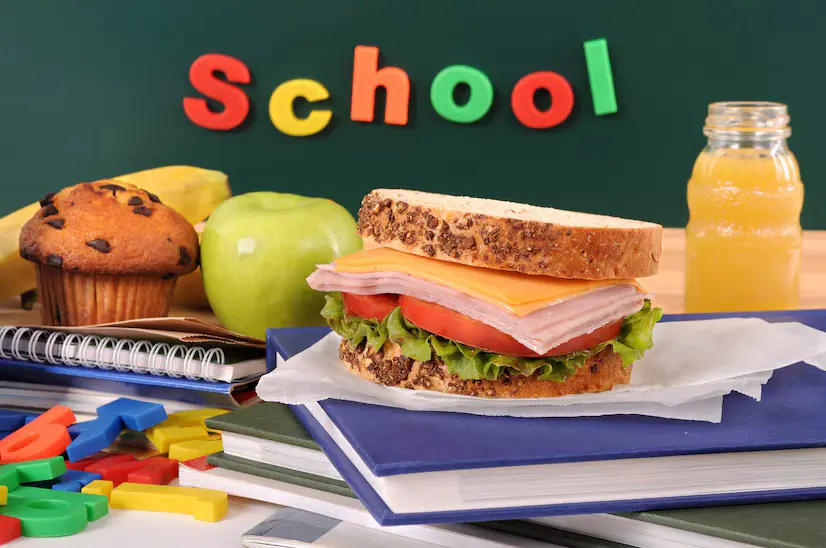Introduction to Streamlining School Food Program Reimbursement
Welcome to a world where School food program reimbursement thrive, reimbursement processes are streamlined, and students’ nutritional needs are met with precision. In the fast paced realm of educational institutions, ensuring that every dollar spent on providing meals aligns seamlessly with reimbursement procedures is crucial. Let’s delve into the realm of optimizing school food program reimbursements together and discover how technology, communication strategies, and staff empowerment can revolutionize the way we nourish young minds.
Understanding the Current Landscape

In today’s ever evolving educational landscape, School food program reimbursement play a crucial role in ensuring students receive nutritious meals. Understanding the current environment is essential to streamline reimbursement processes effectively.
With changing regulations and guidelines, schools must stay informed about compliance requirements to navigate the complexities of reimbursement procedures efficiently. It’s vital to assess how external factors like funding changes or policy updates impact your school’s food program operations.
By staying attuned to industry trends and best practices, you can identify opportunities for improvement and innovation within your reimbursement process. This awareness allows you to proactively address challenges and adapt strategies accordingly.
Moreover, recognizing the unique needs and dynamics of your school community will help tailor solutions that align with specific goals and objectives. Embracing a holistic approach towards understanding the current landscape sets the foundation for optimizing your school food program reimbursement process.
Assessing Your School’s Needs
When it comes to streamlining your school food program reimbursement process, one of the crucial steps is assessing your school’s specific needs. This involves taking a close look at your current procedures and identifying areas for improvement.
Start by gathering feedback from staff involved in the reimbursement process, such as cafeteria managers and administrative personnel. Understanding their pain points and challenges can provide valuable insights into where changes are necessary.
Consider conducting a thorough audit of your existing systems and workflows to pinpoint bottlenecks or inefficiencies that may be hindering the reimbursement process. Look for opportunities to streamline tasks, reduce manual labor, and enhance overall efficiency.
Additionally, take into account any unique requirements or regulations that govern School food program reimbursement in your region. Ensuring compliance with these guidelines is essential for securing reimbursements efficiently.
By carefully assessing your school’s needs upfront, you can lay a solid foundation for implementing effective strategies that will ultimately lead to a more streamlined reimbursement process.
Leveraging Technology Solutions

In today’s fast paced world, leveraging technology solutions is crucial for streamlining your school food program reimbursement process. By incorporating innovative software and tools, you can revolutionize the way data is managed and payments are handled. Technology offers efficiency, accuracy, and convenience in a digital age where speed matters.
Utilizing specialized software tailored to School food program reimbursement can simplify tasks such as tracking purchases, managing inventory, and submitting reimbursement claims. These tools ensure that every step of the process is optimized for maximum effectiveness. By embracing technology solutions, schools can save time while also reducing errors commonly associated with manual processes.
With advanced reporting features and automated functions, technology empowers schools to stay organized and compliant with regulations effortlessly. This modern approach not only enhances operational efficiency but also allows staff to focus on providing nutritious meals to students without getting bogged down by administrative tasks.
By embracing technological advancements in managing your school food program reimbursement process, you set your institution up for success in meeting the needs of students while maintaining financial sustainability.
Choosing the Right Software
When it comes to streamlining your school food program reimbursement process, choosing the right software is key. With various options available in the market, it’s essential to select a solution that aligns with your school’s specific needs and requirements.
Consider software that offers features such as automated data entry, customizable reporting tools, and integration capabilities with existing systems. This will help simplify the reimbursement process and improve efficiency.
Ensure the software you choose is user friendly and provides adequate training and support for your staff. Ease of use is crucial for successful implementation and adoption across different departments within your school.
Look for software that prioritizes security measures to safeguard sensitive financial information related to your school’s food program. Data protection should be a top priority when selecting a software solution.
Additionally, explore software vendors that offer regular updates and maintenance services to ensure seamless functionality over time. Regular updates can enhance performance and address any potential issues proactively.
Implementing a Smooth Transition

Transitioning to a new system can be daunting, but with careful planning and communication, the process can be smooth and successful. Start by clearly outlining the goals and objectives of the transition to all stakeholders involved. This will help set expectations and create a sense of purpose among staff members.
Provide adequate training and support to ensure everyone is comfortable with using the new software or tools. Encourage feedback from employees throughout the transition period to address any concerns or challenges promptly. Open lines of communication are essential for a seamless shift.
Designate a point person or team responsible for overseeing the implementation process. Having dedicated individuals focused on managing the transition can help prevent delays and keep things on track. Regular check ins and progress updates will also aid in identifying any potential issues early on.
Celebrate small victories along the way to boost morale and maintain momentum. Acknowledging milestones achieved during the transition can motivate staff members and reinforce their commitment to embracing change positively. Remember, patience is key when implementing a smooth transition – Rome wasn’t built in a day!
Optimizing Data Management
In today’s digital age, optimizing data management is crucial for streamlining your school food program reimbursement process. By efficiently organizing and analyzing data, you can gain valuable insights into your program’s performance and financial health.
Utilizing robust software systems can help automate data entry tasks, reduce errors, and improve overall efficiency. Implementing standardized procedures for data collection and reporting ensures consistency and accuracy in reimbursement submissions.
By centralizing all relevant information in a secure database, you can easily track expenses, monitor budget allocations, and generate detailed reports for stakeholders. This transparency fosters accountability and enhances decision making processes within your School food program reimbursement.
Regularly auditing your data management practices allows you to identify areas for improvement and implement corrective measures promptly. Embracing a proactive approach to data integrity safeguards against potential compliance issues and mitigates risks associated with inaccurate reporting.
Optimizing data management empowers you to make informed decisions that drive the success of your school food program reimbursement initiatives.
Ensuring Compliance and Accuracy

When it comes to managing your school food program reimbursement, ensuring compliance and accuracy is crucial. By following established guidelines and regulations, you can avoid potential issues and discrepancies that may arise during audits or reviews.
One way to maintain compliance is by keeping detailed records of all financial transactions related to the program. This includes documenting purchases, expenses, and revenue generated through meal sales.
Regularly reviewing your processes and procedures can help identify any areas where improvements are needed to enhance accuracy. Conducting internal audits can also provide valuable insights into how well your system is functioning.
Training staff members on proper protocols and best practices for reimbursement processing can contribute to maintaining consistency and minimizing errors. It’s important for everyone involved in the process to understand their roles and responsibilities.
By staying up to date with regulatory changes in the School food program reimbursement industry, you can proactively adjust your practices to remain compliant at all times. Continuous education on relevant policies ensures that your program operates within legal boundaries while maximizing reimbursements for the benefit of students.
Enhancing Communication Channels
Effective communication is key to streamlining your school food program reimbursement process. Enhancing communication channels within your team and with stakeholders can significantly improve efficiency. Utilizing digital platforms like emails, messaging apps, and project management tools can facilitate quick and clear exchanges of information. Regular meetings or check ins can help ensure everyone is on the same page regarding reimbursement procedures, deadlines, and requirements.
Encouraging open dialogue between departments involved in the reimbursement process can prevent misunderstandings and delays. Providing training on effective communication strategies to staff members can also enhance collaboration and productivity. Implementing a system for feedback from all parties involved in the process can lead to continuous improvement in communication practices.
Utilizing newsletters, bulletin boards, or intranet systems to disseminate important updates or reminders about reimbursement guidelines can keep everyone informed. Creating a centralized platform where stakeholders can access relevant documents or resources easily can further streamline communication processes. By prioritizing transparent and efficient communication channels, you set the stage for smoother operations within your school food program reimbursement workflow.
Empowering Staff with Resources

Empowering your staff with the right resources is crucial for streamlining your school food program reimbursement process. Providing ongoing training and professional development opportunities can help them stay updated on regulations and best practices.
Equip your team with user friendly software tools that simplify tasks like tracking expenses, submitting reports, and monitoring reimbursements. Encourage open communication channels within the staff to share insights and address any challenges they may face.
Offer support in the form of templates, guides, and manuals to assist employees in navigating complex procedures smoothly. Recognize their hard work and dedication through regular feedback sessions or rewards for exceptional performance.
By empowering your staff with resources tailored to their needs, you create a motivated team capable of efficiently managing the school food program reimbursement process.
Streamlining Purchase and Procurement Processes
Looking to optimize your school food program reimbursement process? Streamlining purchase and procurement processes is key to achieving efficiency and cost effectiveness. By centralizing ordering, tracking inventory, and managing vendors, you can reduce unnecessary spending and improve budget management.
Implementing a digital procurement system can simplify the purchasing workflow. This allows for better transparency in pricing, streamlined approvals, and real time monitoring of expenses. Automated alerts for low stock levels or expiring items help prevent shortages or waste.
Establishing clear protocols for selecting suppliers based on quality standards ensures consistent delivery of fresh ingredients. Negotiating contracts with trusted partners can lead to discounted rates and long term savings. Regularly reviewing vendor performance helps maintain accountability and reliability in the supply chain.
By optimizing purchase orders, invoicing procedures, and payment processing through integrated software solutions, you can enhance accuracy in financial transactions while saving time on manual tasks. Embracing technology driven tools empowers your team to focus on providing nutritious meals that support student well being.
Prioritizing Food Safety and Quality

When it comes to School food program reimbursement, prioritizing food safety and quality is non negotiable. Ensuring that the meals served to students are not only delicious but also safe for consumption is a top priority for schools nationwide.
Implementing stringent food safety protocols, such as proper storage of ingredients, thorough cooking processes, and regular cleaning of kitchen facilities, is essential in maintaining high quality standards. By consistently monitoring temperatures, expiration dates, and overall hygiene practices, schools can prevent foodborne illnesses and maintain trust with parents and students.
Collaborating with reputable suppliers who provide fresh and nutritious ingredients is another crucial step in guaranteeing the quality of school meals. Regular inspections of incoming produce and products can help identify any potential issues early on before they reach the cafeteria line.
Training kitchen staff on proper food handling techniques and empowering them to take ownership of maintaining cleanliness standards plays a significant role in upholding food safety measures. Encouraging open communication channels within the team can lead to quick identification and resolution of any potential risks or concerns related to food quality.
By placing emphasis on prioritizing food safety and quality in school meal programs, institutions demonstrate their commitment to providing students with nourishing meals that contribute positively to their overall health and well being.
Addressing Dietary and Nutritional Needs
Ensuring that your School food program reimbursement caters to the diverse dietary and nutritional needs of students is crucial for their well being and academic performance. By offering a variety of options, you can accommodate different preferences, allergies, and cultural requirements.
Consider implementing menu rotations that include vegetarian, vegan, gluten free, and dairy free choices to cater to various dietary restrictions. Work closely with nutritionists or dietitians to create balanced meals that meet recommended guidelines for essential nutrients.
Educate both students and staff on the importance of making healthy food choices. Provide resources such as nutrition workshops or guides to promote awareness about proper nutrition.
Engage with parents to gather feedback on their children’s dietary needs and preferences. Collaborate with them to ensure the menu offerings align with what they believe is best for their child’s health.
Regularly review and update your menu based on nutritional guidelines and feedback from stakeholders. Continuously strive to improve the quality of food served in your school cafeteria for the benefit of all students.
Implementing Sustainable Practices

When it comes to streamlining your school food program reimbursement process, implementing sustainable practices is key. Sustainability isn’t just a buzzword; it’s a crucial aspect of ensuring the long term health and success of your program. By incorporating eco friendly initiatives into your operations, you can reduce waste, lower costs, and make a positive impact on the environment.
Start by assessing areas where you can make changes to minimize your carbon footprint. This could involve sourcing ingredients locally, reducing single use plastics, or composting food scraps. Educate staff and students about the importance of sustainability and encourage them to participate in green initiatives.
Consider partnering with local farms or suppliers who prioritize sustainable practices. By supporting businesses that share your values, you can create a more environmentally conscious supply chain. Additionally, explore ways to incorporate renewable energy sources into your operations, such as solar panels or energy efficient appliances.
By taking steps to implement sustainable practices in your School food program reimbursement, you not only contribute to a healthier planet but also set an example for future generations. Remember that even small changes can have a big impact when it comes to building a more sustainable future for all.
Engaging with Parents and Students
Engaging with parents and students in your School food program reimbursement is crucial for success. One way to foster this connection is by hosting tasting events where families can sample new menu items together. This not only allows for feedback but also creates a sense of community around food.
Another idea is to involve students in the meal planning process by seeking their input on favorite dishes or snacks they would like to see on the menu. This empowers them and ensures that their preferences are taken into consideration.
Communication is key, so consider sending out regular newsletters or emails updating parents and students on upcoming menu changes, nutrition information, or fun food facts. Encouraging open dialogue can help build trust and transparency within the School food program reimbursement.
Additionally, organizing cooking classes or nutrition workshops for both parents and students can be a great way to educate about healthy eating habits while also strengthening relationships within the school community. By engaging with parents and students in these creative ways, you are fostering a positive relationship that benefits everyone involved.
Monitoring and Measuring Success

As you streamline your school food program reimbursement process, monitoring and measuring success becomes crucial. This involves tracking key performance indicators to ensure efficiency and effectiveness in managing finances and resources.
One way to monitor success is by analyzing reimbursement data regularly to identify trends and areas for improvement. By setting measurable goals, such as increasing reimbursement accuracy or reducing processing times, you can track progress over time.
Implementing feedback mechanisms with staff, parents, and students can provide valuable insights into the impact of your streamlined processes on overall satisfaction levels. Utilizing surveys or focus groups can help gather qualitative data that complements quantitative metrics.
Regularly reviewing financial reports and budget allocations allows you to make informed decisions based on real time data, ensuring that resources are allocated efficiently. By continuously evaluating performance metrics against established benchmarks, you can adapt strategies as needed to maintain a successful reimbursement process flow.
Addressing Common Pitfalls and Challenges
Navigating the school food program reimbursement process can come with its fair share of challenges and pitfalls. One common issue schools face is incomplete or inaccurate documentation, leading to delays in reimbursement. This can be addressed by implementing thorough training for staff members responsible for maintaining records.
Another challenge is staying up to date with changing regulations and requirements from governing bodies. It’s essential to designate a staff member or team to stay informed about any updates and ensure compliance at all times.
Budget constraints may also pose a hurdle, impacting the quality and variety of food offered in school programs. Schools can explore creative solutions like partnering with local vendors or applying for grants to supplement funding.
Communication breakdowns between different departments involved in the reimbursement process can lead to confusion and errors. Establishing clear communication channels and regular meetings can help streamline operations effectively.
By proactively identifying and addressing these common pitfalls, schools can enhance their reimbursement processes for smoother operations overall.
Celebrating Achievements and Milestones

Celebrating Achievements and Milestones is a crucial aspect of any school food program reimbursement process. It’s essential to acknowledge the hard work and dedication of everyone involved, from staff members to students. Recognizing milestones achieved not only boosts morale but also motivates individuals to continue striving for excellence.
Whether it’s reaching a certain percentage of compliance or implementing a new sustainable practice, every achievement should be celebrated. This not only fosters a sense of pride within the team but also encourages continuous improvement in the program.
From hosting appreciation events to sharing success stories on social media platforms, there are various ways to celebrate achievements and milestones. By highlighting successes, you inspire others to push boundaries and set new goals for the future.
Remember, celebrating achievements is not just about patting oneself on the back; it’s about acknowledging progress made and setting the stage for even greater accomplishments ahead. So take time to revel in your wins and use them as fuel for future advancements in your school food program reimbursement journey!
Looking Towards Future Innovations
As schools continue to evolve, so too must their food programs. Looking towards future innovations in school food program reimbursement means embracing cutting edge technologies and practices that enhance efficiency and accuracy. One exciting trend on the horizon is the integration of artificial intelligence and machine learning algorithms to streamline data management processes.
Furthermore, leveraging mobile applications for meal tracking and reimbursement submissions can revolutionize how schools interact with payment systems. By exploring blockchain technology for secure transactions, schools can ensure transparency and accountability in their financial operations.
In addition, incorporating sustainable practices like farm to school initiatives can not only support local communities but also promote environmental stewardship. With a focus on reducing waste through composting programs and eco friendly packaging solutions, schools can lead by example in sustainability efforts.
By staying ahead of the curve and embracing these innovative approaches, School food program reimbursement can set themselves up for long term success and impact positively on students’ well being.
Conclusion: Sustaining Streamlined Processes
As schools continue to navigate the complexities of managing their food programs and seeking reimbursement, streamlining processes is essential for efficiency and success. By implementing the tips and tricks outlined in this article, schools can optimize their reimbursement processes, improve compliance, enhance communication channels, empower staff, prioritize food safety and quality, address dietary needs, engage with stakeholders effectively, monitor progress accurately, overcome challenges proactively, celebrate achievements proudly,and remain open to future innovations.
Sustaining streamlined processes requires ongoing dedication to continuous improvement and adaptation to evolving needs. With a commitment to efficiency and excellence in School food program reimbursement management,reimbursement process can be streamlined successfully for the benefit of students,schools,and communities alike.

